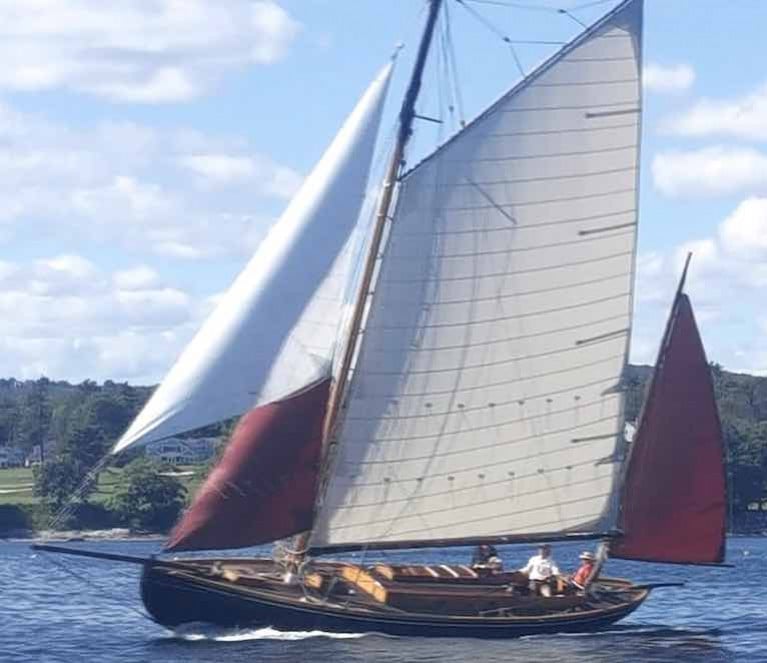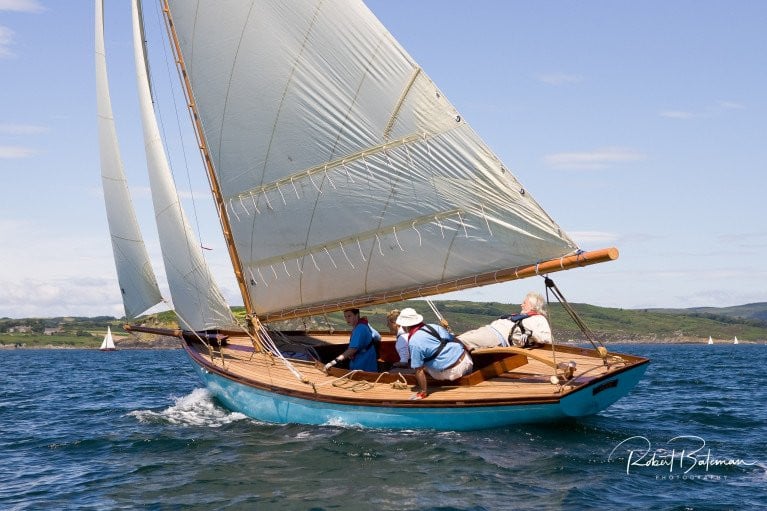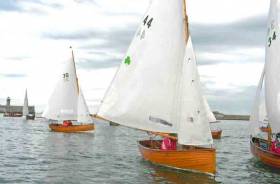Displaying items by tag: Classic boats
Up to 20 French Classic Yachts Expected for Cork Week 2022
Royal Cork's Paris Boat Show announcement last December that there is to be a dedicated Classics Class at Volvo Cork Week has been receiving a steady uptake of entries.
As Afloat reported earlier, a former famous Morning Cloud yacht from the UK will compete in Cork Harbour and more recently, the club has announced it is expecting up to 20 yachts from France.
Last December, Pascal Stefani, President of the Atlantic Yacht Club, with the support of the Yacht Club de France, announced that they were arranging "Goto Cork 2022", a movement which will entail up to 20 yachts heading to Cork via the Scillies to participate.
A delegation from AYC has since been to Cork to prepare for their visit in July.
Local classics are also entered, including Terry Birles' 'Erin' who was one of the first entries for the new Classic division.
As regular Afloat readers will know, Birles and Erin took fifth in their class in the St. Tropez classic regatta last September.
The RCYC has also revealed the series will be conducted using the Jauge Classique Handicap (JCH) system to allow classic boats with very different characteristics to race together and other handicapping systems as appropriate.
Ireland's Classic & Traditional Boats Give Us Hope in Challenging Times
In this time of increasing uncertainty with its frustration of sailing plans, we find reassurance in soothing thoughts of well-restored or new-built classic boats. And traditional vessels in handsome and workmanlike order have the same heartening effect. We've an instinct for properly-used and sensibly-deployed timber in our DNA, for in prehistoric times, it was a significant survival asset. Now, it reminds us of the need for patience, and we find comfort in clichés, not least in the old chestnut that when God made time, he made a lot of it.
For time can be a matter of the greatest importance with the restoration of classics. This month, John Kearney's great Mavis – built in Ringsend in Dublin in 1923-25 - is sailing again in Maine, after a restoration which has lasted very many years. And in so doing, she and those who have brought her back to life remind us of how much has been achieved in recent times to preserve and restore Ireland's historical boats. Perhaps most encouragingly of all, they've been restored not as lifeless museum pieces, but rather as vigorous members of the nation's active fleet, providing inspiring sailing and some excellent racing sport.
 Mavis as she will be when her sails have become a complete suit. It is 1928, Mavis has been completed for three years, and she is seen here with Skipper Kearney in full command, sweeping into the finish before an appreciative audience to win Skerries Regatta. For twenty-five years, Skipper Kearney and Mavis were regarded as star turns on Ireland's East Coast, with a formidable record in both inshore and offshore racing. Photo: Courtesy Ronan Beirne
Mavis as she will be when her sails have become a complete suit. It is 1928, Mavis has been completed for three years, and she is seen here with Skipper Kearney in full command, sweeping into the finish before an appreciative audience to win Skerries Regatta. For twenty-five years, Skipper Kearney and Mavis were regarded as star turns on Ireland's East Coast, with a formidable record in both inshore and offshore racing. Photo: Courtesy Ronan Beirne
But before we delve into the new life which is being found for wooden one-design classes and other special vessels of very varying vintages, we must pay our respects to John B Kearney, and to Ron Hawkins and Denise Pukas and their friends and helpers in Camden in Maine, who have patiently brought Mavis back to life. They've progressed the work as time and resources become available, for Ron is a master shipwright from a noted maritime family, and his skills are much in demand by others.
In its Dublin way, John B Kearney's Ringsend background superficially seems not to have been so very different, yet his was a life which would have been remarkable by any standards, in any place, at any time. For in the Dublin of its era, this was a life of astonishing achievement against all the odds in a rigidly structured society made even more conservative by a time of global unrest and national upheaval.
Yet here was a largely self-taught young many who was to design many boats – including the Dublin Bay Mermaid in 1932 – who quietly yet steadily progressed with his zest for life undimmed – he was still designing boats in his eighties – while the respect he received in the sailing world was such that he was a Flag Officer of the National Yacht Club in Dun Laoghaire – for he had long since moved from Dublin city to Monkstown – for the last 20 years of his life.
 The eternal enthusiast. John B Kearney, aged 83, at work in 1963 on the plans of his largest yacht, the 53ft Tyrrell of Arklow-built Helen of Howth
The eternal enthusiast. John B Kearney, aged 83, at work in 1963 on the plans of his largest yacht, the 53ft Tyrrell of Arklow-built Helen of Howth
John Breslin Kearney (1879-1967) was born of a longshore family in the heart of Ringsend in Dublin, the eldest of four sons in a small house in Thorncastle Street. The crowded old houses backed onto the foreshore along the River Dodder in a relationship with the muddy inlet which was so intimate that at times of exceptional tidal surges, any ground floor rooms were at risk of flooding.
But at four of the houses, it enabled the back yards to be extended to become the boatyards of Foley, Murphy, Kearney and Smith. Other houses on Thorncastle Street provided space for riverside sail lofts, marine blacksmith workshops, traditional ropeworks, and all the other long-established specialist trades which served the needs of fishing boats, and the small vessels - rowed and sailed - with which the hobblers raced out into Dublin Bay and beyond to provide pilotage services for incoming ships.
And increasingly, as Dublin acquired a growing middle class with the burgeoning wealth of the long Victorian era, the little boatyards along the Dodder also looked after the needs of the boats of the new breed of recreational summer sailors.
The young John Kearney was particularly interested in this aspect of activity at his father's boatyard, where he worked during time away from school. From an early age, he developed a natural ability as a boat and yacht designer, absorbing correspondence courses and testing his skills from 1897 onwards, when he designed and built his first 15ft sailing dinghy, aged just 18.
In adult life, during the day he worked initially as a shipwright in Dublin Port & Docks, but his skills could be so broadly applied that he rose rapidly through the ranks to become involved in the work of many departments, such that by the time of his retiral in 1944, while he was officially the Superintendent of Construction Works, in reality, he was the Harbour Engineer, yet couldn't be so named as he had no university degree.
However, this lack of an official title left him unfazed, for his retirement at the age of 65 meant he could concentrate full-time on his parallel career as a yacht designer, something that was so important to him that when his gravestone was erected in Glasnevin in 1967, it simply stated: John Kearney, Yacht Designer.
 The Skipper – John Kearney, in the companionway of Mavis, keeps an eye on the making breeze in Dun Laoghaire on a Saturday afternoon in the summer of 1950. Photo: Richard Scott
The Skipper – John Kearney, in the companionway of Mavis, keeps an eye on the making breeze in Dun Laoghaire on a Saturday afternoon in the summer of 1950. Photo: Richard Scott
 Born again. The restored Mavis at anchor in Maine, September 2020. Photo: Denise Pukas
Born again. The restored Mavis at anchor in Maine, September 2020. Photo: Denise Pukas
That he was also a master boatbuilder who had been able to design and build fine yachts in his spare time isn't stated, but over the years he created many, and the 38ft Mavis for himself in 1925 was a masterpiece, with an astonishingly good performance which was such that after racing unsuccessfully against John Kearney and Mavis in a stormy offshore race in the Irish Sea in 1935, Humphrey Barton – who later founded the Ocean Cruising Club in 1954 - was moved to write an article for Yachting World drawing attention to this relatively unsung sailing star from Dublin Bay.
John Kearney's determination to be a full-time yacht designer after his retirement was such that in 1951 he sold Mavis to Paddy O'Keeffe of Bantry, as his yacht design clients expected him to sail part of each season in their new Kearney-designed boats and Mavis wasn't getting the use she deserved. She returned briefly to Dublin Bay in 1956 in the ownership of Desmond Slevin, a ship's doctor who was given a lucrative posting in the US, so he had Mavis shipped across the Atlantic, and she has been New England-based ever since.
She has been both lucky and unlucky in her time in America. Lucky in that there has always been someone who recognised that there was something special in this characterful boat that made her worth preserving. Yet unlucky in that it was never someone with the substantial resources to restore her completely to the classic yacht standards to which John Kearney has so skillfully and painstakingly built her, for such people put their wealth into recognised brands such as Herreshoff, Fife, Sparkman & Stephens, and John Alden.
 A lot done, and much more still to do. Ron Hawkins in the stripped-out hull of Mavis. Photo: Tim Magennis
A lot done, and much more still to do. Ron Hawkins in the stripped-out hull of Mavis. Photo: Tim Magennis
Yet the fates were kind in letting Ron Hawkins see the spark that might be found in Mavis, and many years ago he took her over with the intention restoring her as time and funds became available from his work as a master shipwright. It was bound to be a long time, as the rising enthusiasm for classic and traditional craft kept him busy - sometimes until late into the night - at the waterfront boatyards. But he moved Mavis to a workshop on the outskirts of town and started the long process of stripping her out and gradually bringing her back to John Kearney standards, with the supportive arrival of Denise Pukas boosting his enthusiasm for a quality project which at times looked like it might stretch into infinity.
 The restored Mavis, newly-launched in 2015, with Don O'Keeffe (nephew of Paddy O'Keeffe) on the tiller in the cockpit with Denise Pukas, and Ron Hawkins in the inflatable
The restored Mavis, newly-launched in 2015, with Don O'Keeffe (nephew of Paddy O'Keeffe) on the tiller in the cockpit with Denise Pukas, and Ron Hawkins in the inflatable
 The inevitable hiatus. Mavis awaiting her spars and sails
The inevitable hiatus. Mavis awaiting her spars and sails
Regular readers of Afloat.ie will know that the restored Mavis was finally put in the water in Camden in 2015. Yet with a boat and rig like this, much remained to be done, and always there were the demands of other income-generating projects. Thus it wasn't until the pandemic loomed over the horizon that boatyard work slackened, and there was an unexpected time in the Spring of 2020 to complete the mast and rigging, and get it stepped.
Even when doing it yourself to the extent – as Ron did – of personally making the gaff-boom leather saddle, it's still costly when you're doing it to top Kearney standards, as the best of materials are expected. And though we were receiving photos through the summer of the mast being stepped and dressed, the cryptic attached message said no more than: "Still waiting for the mainsail".
 In late summer 2020, the new mainsail finally arrived. Photo: Denise Pukas
In late summer 2020, the new mainsail finally arrived. Photo: Denise Pukas
Thus it seemed that the Mavis sailplan was being assembled from bits and pieces, whereas a full-blown high-budget project would rely for the final effect on a very complete sailplan, such as Mavis was showing in style at Skerries regatta in 1928.
Be that as it may, early in September, we received an untitled snap showing the mainsail finally in place, other photos arrived showing her taking her first tentative steps under main and jib, and then today's header photo arrived showing Mavis making effortless knots under a slightly eccentric rig derived from several sources, with a high-flying jib which in time may well become the jib topsail in the complete version.
When you've been undertaking a major restoration ashore and afloat with close personal involvement at every stage, it's quite a step from working to actually sailing, which is why in the traditional world there was a clear demarcation between builders and sailors. Thus it has taken a little while to become accustomed to the fact that the Mavis which everyone has known for years as something steady and secure in the workshop, or sitting serenely afloat in the Inner Harbor in Camden, is now a living thing which heels as her sails fill with power, and the sound of the sea chuckles past her easily-driven hull as she lifts to the waves.
But in that lovely Fall weather with which Maine is often blessed, they've been getting about, and a visit across to Eggemoggin Reach saw greetings from legendary photographer Benjamin Mendlowitz and a brief vid and immediate fame on his Instagram page. It tells us much about the easily-driven hull that John Kearney gave Mavis, as he gave her the most subtle set of lines with sweeping sheer and double curves in just about every direction to produce the boat that Humphrey Barton particularly recognised as being at one with the sea.
Benjamin Mendlowitz's glimpse of Mavis as published on Instagram
This elevation of the restored Mavis into a place in sailing's Hall of Fame is a timely reminder of the many other Irish projects – accelerating in number in recent years – which have paid the proper respect to Ireland's finest classic yachts and traditional boats by restoring them to full seagoing strength.
It's now a long time since Nick Massey began the restoration of the Howth 17s in 1972, a baton since taken up by Ian Malcolm, while across in Dun Laoghaire Hal Sisk was into an early episode of what has now become an epic tale beginning with the tiny Fife cutter Vagrant of 1884 – he restored her for her Centenary in 1984 – while also being involved with reviving the Water Wags, raising the profile of the Bantry Boat, restoring the 1894 Watson 36-footer Peggy Bawn with Michael Kennedy of Dunmore East for international stardom in 2005, and most recently bringing the Dublin Bay 21s back to life with the hugely-talented Steve Morris of Kilrush, a project also involving Dan Mill.
 Hal Sisk's 1894-built Peggy Bawn – seen here sailing at Glandore Classics - set a new standard for authentic restoration in 2005
Hal Sisk's 1894-built Peggy Bawn – seen here sailing at Glandore Classics - set a new standard for authentic restoration in 2005
Other groups had already taken on the very major project of a new life for the Dublin Bay 24s, and while it was a complex scheme which proved painful for some, the innate quality of the original Alfred Mylne design has shone through. Periwinkle is now in pristine restored condition in Dun Laoghaire, Zephyra is nearing re-completion at the ApprenticeShop in Maine (where they're also building a Water Wag), and Arandora is entering a re-build project in St Nazaire where Mike Newmeyer of Skol ar Mor has been commissioned to create a new boat-building school.
But we don't have to go abroad for classic boat-building skills, as Dougal McMahon of Athlone has taken on the mantle of the late Jimmy Furey – legendary builder of Shannon One Designs – and is currently restoring the 1930-built Water Wag Shindilla, a boat with long links to the Falkiner and Collen families, while down in West Cork Rui Ferreira has shown himself on top of the job in building in clinker for the Castlehaven Ette class, the International 12s, and the Water Wags, while being equally adept in putting a new teak deck on the Howth 17 Deilginis.
 Thriving in various forms since their foundation in 1887, the Dublin Bay Water Wags currently number 50 registered boats in racing condition
Thriving in various forms since their foundation in 1887, the Dublin Bay Water Wags currently number 50 registered boats in racing condition
Nearby, Tiernan Roe has taken on a variety of skilled work and is currently linked to the re-build of the O'Keeffe family's Lady Min (designed and built by Maurice O'Keeffe of Schull in 1902), while round the corner in Oldcourt on the Ilen River above Baltimore, Liam Hegarty is the sure and steady presence who restored the Ilen herself through a time-scale which rivals the re-birth of Mavis, and while as ever he's distracted by urgent work needing doing on fishing boats, the re-build of Conor O'Brien's Saoirse is proceeding steadily in the Top Shed with the hull caulked and the spars currently being made.
 Irish craftsmanship sails the Arctic….the Baltimore-built Trading Ketch Ilen of Limerick in Greenland, July 2019. Photo: Gary Mac Mahon
Irish craftsmanship sails the Arctic….the Baltimore-built Trading Ketch Ilen of Limerick in Greenland, July 2019. Photo: Gary Mac Mahon
 The distinctive shape of Conor O'Brien's world-girdling Saoirse continues to re-emerge at Oldcourt in West Cork, as seen yesterday (September 18th). The poop deck and the familiar main deck and coachroof are taking shape, while the hull has already been caulked. Photo: Paddy Hegarty
The distinctive shape of Conor O'Brien's world-girdling Saoirse continues to re-emerge at Oldcourt in West Cork, as seen yesterday (September 18th). The poop deck and the familiar main deck and coachroof are taking shape, while the hull has already been caulked. Photo: Paddy Hegarty
Along the south coast beyond Kinsale in Nohoval is Cork Harbour sailing's best-kept secret, Walsh Boat Works, where Jim Walsh creates classic finishes to Chippendale standards for quality craft such as Pat Murphy's charming Colleen 23 Pinkeen and the International Dragon Fafner. The latter is currently on the market for anyone seeking a top entry boat to join that special group of classic Dragons in Glandore which, back in July, helped the great Don Street celebrate his 90th birthday.
 How about that then? The immaculate deck of the restored classic Dragon Fafner as she emerged from Walsh Boatworks of Nohoval. Photo Dan O'Connell
How about that then? The immaculate deck of the restored classic Dragon Fafner as she emerged from Walsh Boatworks of Nohoval. Photo Dan O'Connell
Jim Walsh is also making input into another significant Cork harbour yacht restoration which will see the light of day in due course, but meanwhile, his involvement with Dragons is a reminder that the interest in restoring them is reflected up north, where a secret workshop near Ballyhornan beside the entrance to Strangford Lough has seen the Dragon Skeia superbly restored, and they're now working on a very special bit of Irish Dragon history, the late great Jock Workman's Dalchoolin which is being restored to former glory after her hull and keel were retrieved from two different locations.
 You wouldn't expect to find worthwhile restoration projects in a shiny showroom – this is the legendary International Dragon Class Dalchoolin being unearthed in multi-purpose premises on the Ards Peninsula in County Down. Photo: James Nixon
You wouldn't expect to find worthwhile restoration projects in a shiny showroom – this is the legendary International Dragon Class Dalchoolin being unearthed in multi-purpose premises on the Ards Peninsula in County Down. Photo: James Nixon
 On closer examination, Dalchoolin proved to be eminently restorable, and the work is now under way. Photo: James Nixon
On closer examination, Dalchoolin proved to be eminently restorable, and the work is now under way. Photo: James Nixon
This leap from Cork Harbour to Strangford Lough seems to leave the East Coast and Dublin in particular devoid of the classic skills, but they're there in Arklow if you know whom to seek, while in Dublin, there's Larry Archer's impressive record in restoring boats with Ian Malcolm of the Howth 17s and the Water Wags, particularly impressive in that Larry can somehow find a flicker of life in a very damaged boat which others might have been too ready to write off as a total loss, while in Howth Johnny Leonard worked wonders in bringing the Bourke family's L Class Iduna back to better-than-new condition.
 The L Class Iduna's restoration by Johnny Leonard created a little classic glowing with health. Photo: W M Nixon
The L Class Iduna's restoration by Johnny Leonard created a little classic glowing with health. Photo: W M Nixon
As for traditional craft, the great Clondalkin-built Galway Hooker Naomh Cronan need skilled work done before she was moved to her new home in Galway city, and the job was done in style in Malahide by Donal Greene whose credentials are unrivalled, as he's from Connemara, he's descended in a long line from natural boatbuilders whose skills he manifests, and yet he has an enviable affinity for working with computers when planning how best to utilise the available amount of timber for a specific job.
 Guy & Jackie Kilroy's Marguerite, a Herbert Boyd design built in Malahide in 1896, is a restoration by Larry Archer
Guy & Jackie Kilroy's Marguerite, a Herbert Boyd design built in Malahide in 1896, is a restoration by Larry Archer
We seem to have a come a long and meandering way, travelling from the first sail in decades by John Kearney's Mavis in her new Maine home, to the skills of Larry Archer and others in putting vigorous new life into classic old boats here in Ireland. But the message is that the skills are available, the enthusiasm is there, and when the current pall over all our lives is lifted, the fleet will be there and ready to sail.
Glandore Classics Regatta Another Victim of Coronavirus
Glandore Harbour Yacht Club has cancelled its Classic Regatta which had been scheduled to start on July 18.
Since it was first held on a July weekend in 1992 Glandore Classic Boats Regatta has developed into an outstanding event, “where the masterpieces of the great age of sail mingle with traditional West Cork workboats for a regatta of sailing and spectacle.”
This year’s event was intended to join with the Tricentenary celebrations of the Royal Cork Yacht Club’s 300 years, having been postponed from last year, which would have been its normal two-year cycle schedule.
So the decision by the committee of Glandore Harbour Yacht Club to postpone the event is a double “whammy” and will also be a big blow to the local tourist economy.
There wasn’t much alternative.
Sailing Secretary, Hal Andrews, told Afloat the reasons: “Social distancing requirements affect our ability to provide support and safety boat cover, ferry boat services, all social activities, club facilities, etc. We would have had to postpone, anyway, under current Irish Sailing ‘Back-to-Sailing plans. And it is impossible to know whether a return to lockdown definitely will not happen. We will make a decision later about whether to reschedule for 2021 or 2022, to link again to Cork 300 as originally planned.”
The combination of a new venue for a gathering of classic boats – Glandore Harbour’s natural amphitheatre, a warm welcome and the growing interest in traditional boats, contributed to the success of event after its first year. That had attracted a fleet of local and visiting traditional and classic boats. The original ‘Parade of Sail’ has been a strong spectator and visitor feature since the outset that has always been included and the ‘Classics’ has survived some turbulent weather conditions.
After the Millennium the biennial cycle regatta was re-titled Glandore Classic Regatta. While the Traditional and West Cork Mackerel Yawls and Lobster boats formed the backbone of the event, the regatta attracted a fleet of classic yachts, one-designs and classic day-boats. In following regattas, the Water Wags arrived from Dublin Bay to showcase formation sailing under the baton of Hal Sisk. The first of the Heir Island Sloops and the revived Cork Harbour One-Designs participated. The Fastnet Race for bigger boats was added to the programme. The Castletownshend ETTE Class raced, Howth 17’s took part as well as Conway Fifes, Shannon One-Designs and Classic Dragons as interest in the regatta expanded.
“An outstanding event where the masterpieces of the great age of sail mingle with traditional West Cork workboats for a regatta of sailing and spectacle. A ‘must-see’ on the sailing calendar for connoisseurs of classic, traditional or even just plain odd boats, it’s a feast for the eye, the memory with vividly contrasting boats all united in at least one purpose,” was one of the descriptions lavished on the event, I’ve had the pleasure of sailing in it several times aboard the late Guy Perrem’s MAB out of Monkstown Bay, which brought great pleasure to him when she took prizes back to Cork Harbour a number of times.
This year’s event was set to be the biggest and most exciting of the series as Glandore Harbour YC partnered with the RCYC’S Cork 300 with the possibility of bringing outstanding classic boats from around the world to the West Cork coast.
Its postponement is another of the long list of sailing event casualties due to the current health pandemic.
Listen to the podcast below
The entry has opened for July's JPF 2020 Glandore Classic Boat Regatta with a 20% discount for all entries until the end of April.
As Afloat previously reported, recognising that there will be an unprecedented ‘Gathering’ of extraordinary boats in Cork to celebrate the 300th anniversary of the Royal Cork Yacht Club, the Glandore Classic Regatta is being scheduled so that classic boats can participate in both events, and then go on to the Cowes Classic Regatta.
Organisers say entries are already starting to come in for the West Cork event. Click here to get to the Notice of Race and online entry.
Tim Magennis, the doyen of the traditional and classic boat movement on Ireland’s east coast, and one of the main movers in many significant historic sailing events in Ireland and the Irish Sea, was acclaimed with elevation to Honorary Life Membership of the internationally-represented Old Gaffers Association at its Annual General Meeting in London at the weekend writes W M Nixon.
It was a significant annual occasion from which the Dublin Bay Old Gaffers Association has returned with three major awards. Led by President John Wedick with Honorary Secretary Mark Sweetnam masterfully presenting the DBOGA case, the Irish contingent came back with Honorary Life Membership for Tim Magennis, plus the Cape Horn Trophy for Seamanship which went to Darryl Hughes for his already and deservedly widely-honoured Round Ireland Race with the gaff-rigged 81-year old ketch Maybird, and the “Grumpy Two” Cups, which went to DBOGA member Paddy Murphy of Renvyle in Galway, and his 16-year-old grandson Conor.
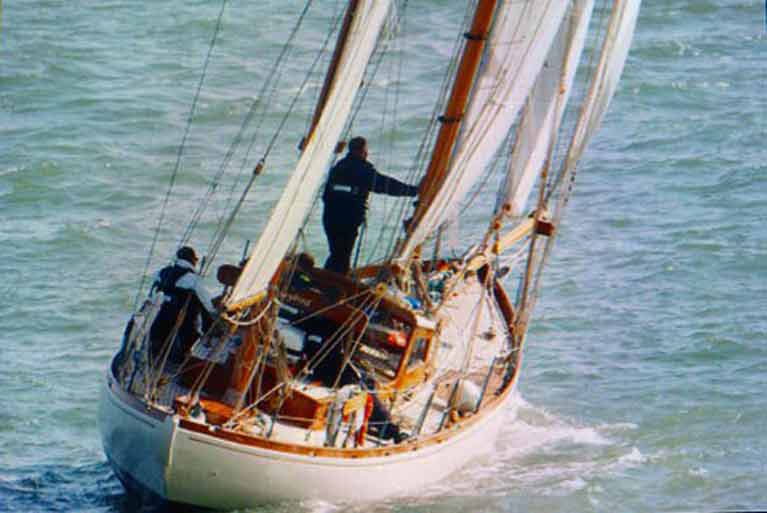 Darryl Hughes’ restored 1937 Tyrrell of Arklow ketch Maybird has received many awards for her completion of the 2018 Round Ireland Race from Wicklow, and now she can add the Old Gaffers Association Cape Horn Trophy to her collection
Darryl Hughes’ restored 1937 Tyrrell of Arklow ketch Maybird has received many awards for her completion of the 2018 Round Ireland Race from Wicklow, and now she can add the Old Gaffers Association Cape Horn Trophy to her collection
The “Grumpy Two” Cups are for a successful gaff-rigged venture by a senior skipper and a junior crew, and Paddy and Conor were awarded for their success in completing a round Ireland cruise with the restored 1916 Manxy Nobby Aigh Vie. This was a circuit which eventually brought Aigh Vie from the Connemara coast southabout of Ireland to her birthplace of Peel in the Isle of Man in time for the Peel Traditional Boat Festival, then northabout back to the Atlantic and Connemara. It was a major challenge, yet having met them during their circuit cruise, I can assure you that far from being grumpy, Paddy and Conor were notably cheerful in getting on with the task they’d set themselves.
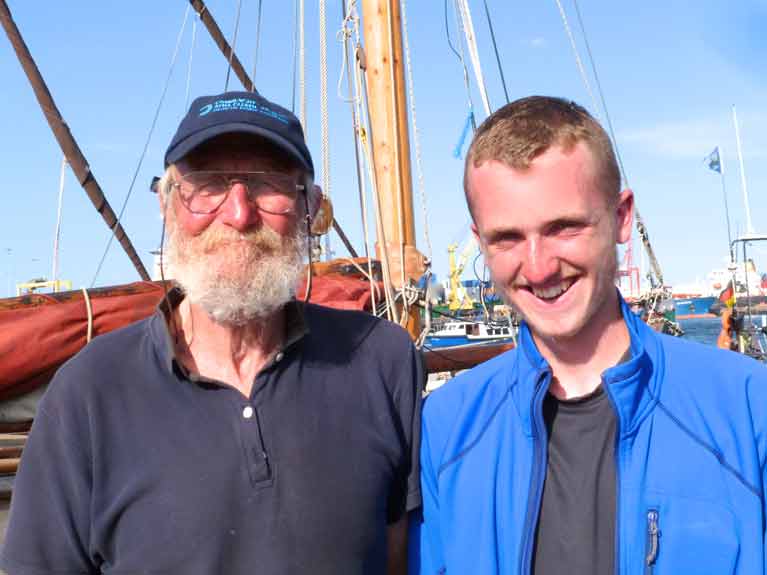 Paddy Murphy and his grandson Conor – notably cheerful winners of the “Grumpy 2” Cups. Photo: W M Nixo
Paddy Murphy and his grandson Conor – notably cheerful winners of the “Grumpy 2” Cups. Photo: W M Nixo
 On her way to her birthplace in the Isle of Man….the newly-restored Aigh Vie coming into Dublin Bay through Dalkey Sound. Photo: Gill Mills
On her way to her birthplace in the Isle of Man….the newly-restored Aigh Vie coming into Dublin Bay through Dalkey Sound. Photo: Gill Mills
What they were doing was particularly appreciated by Tim Magennis, as he had known Aigh Vie as a fishing boat during his childhood. In fact, he is uniquely qualified to have fulfilled his many roles involving traditional rig and classic boats, as he is one of the few people who has actually sailed round the world under gaff rig. He did so as a crew-member on the classic Colin Archer ketch Sandefjord in 1965-67, and this remarkable sea story was featured on Afloat.ie on 20th April 2013 when Tim was President of the Dublin Bay Old Gaffers Association, of which he'd been a founding member in the late 1980s.
2013 saw the celebration of the OGA’s Golden Jubilee with an international OGA rolling circuit cruise round Britain that came west to Dublin Bay for a series of combined and successful events which became the highlight of the year’s celebrations. Tim Magennis was central to all the organisation based on Poolbeg Y&BC in Dublin Port, and in particular, he was the prime mover in the inaugural staging of the DBOGA Leinster Trophy Race, which brought together a superb fleet of classic and traditional craft from six different countries.
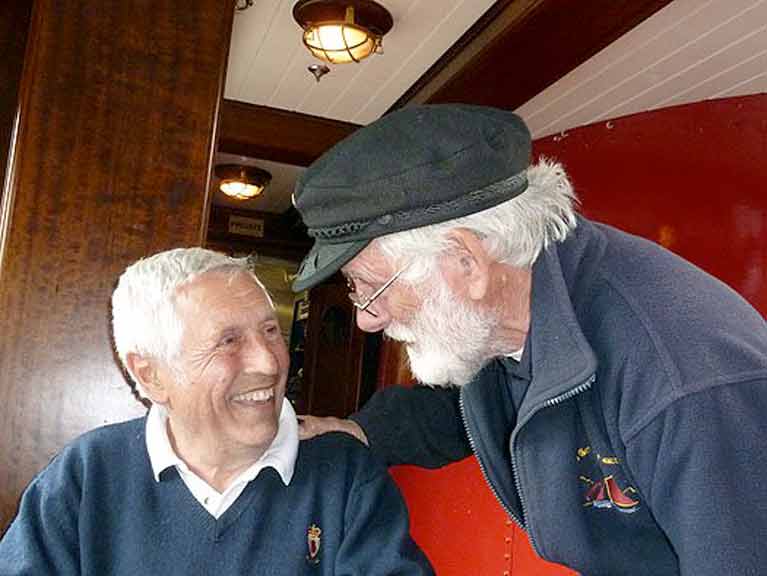 Dickie Gomes, owner of the 1912-built Ainmara which was the first winner of the Leinster Trophy in 2013, with Tim Magennis, at that time President of Dublin Bay OGA. Photo: W M Nixon
Dickie Gomes, owner of the 1912-built Ainmara which was the first winner of the Leinster Trophy in 2013, with Tim Magennis, at that time President of Dublin Bay OGA. Photo: W M Nixon
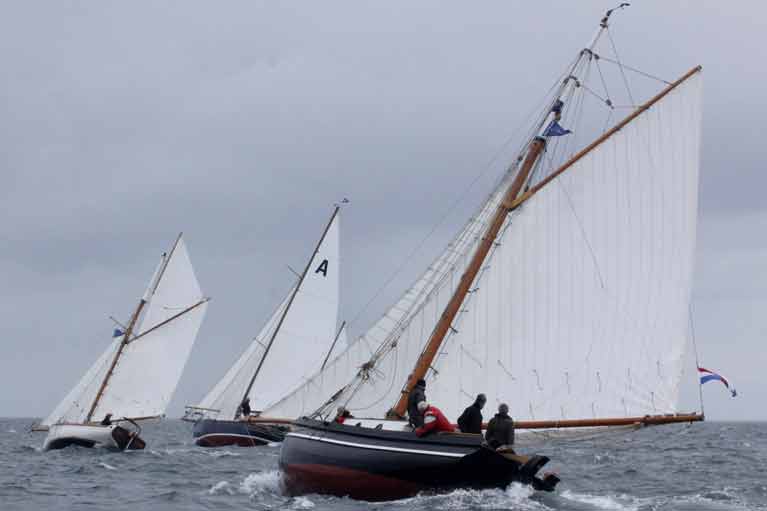 International competition in the first Leinster Trophy Race in 2013, with the Dutch-owned Raven (left) and Cinemara (also from The Netherland, right) with eventual winner Ainmara fom Strangford Lough between them. Photo: Dave Owens
International competition in the first Leinster Trophy Race in 2013, with the Dutch-owned Raven (left) and Cinemara (also from The Netherland, right) with eventual winner Ainmara fom Strangford Lough between them. Photo: Dave Owens
Having spent his childhood in the fishing port of Ardglass on the County Down coast, Tim had in boyhood frequently been aboard such famous Irish Sea fishing boats with Isle of Man connections as Vervine Blossom and White Heather in addition to Aigh Vie. Thus it was a particular pleasure to him that in July 2018 Aigh Vie reappeared fully restored, sailing into Dublin Bay from Ireland’s West Coast and on her way to success, though not until after the weather had severely tested Paddy Murphy’s work.
Tim Magennis’s own early life-path had been adventurous as an international journalist working mainly in Africa, which meant that the circumnavigation in Sandefjord with the brothers Pat and Sean Cullen started and finished at Durban in South Africa.
But with the Sandefjord voyage completed, he was soon to return to Ireland and settle in Dublin where, after another period in journalism, he created a unique niche to which he was particularly suited. This was working in Public Relations for Bord Failte (the Irish Tourist Board) in the exciting days when today’s Irish hospitality industry was finding its feet, and Tim was frequently its very effective voice.
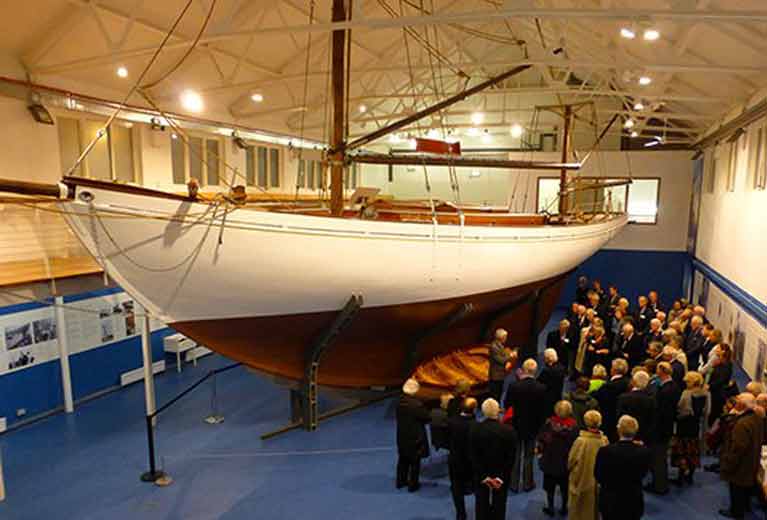 The conserved Asgard on display in Collins Barracks Museum – Tim Magennis played a leading role in ensuring that this historic ketch received the attention she deserved. Photo: W M Nixon
The conserved Asgard on display in Collins Barracks Museum – Tim Magennis played a leading role in ensuring that this historic ketch received the attention she deserved. Photo: W M Nixon
This enabled him to refresh his involvement with Irish seafaring and traditional craft, and he was one of those who ensured that Erskine Childers’ historic 1905 ketch Asgard never faded from public memory, such that in due course a full programme was put in place which has resulted in Asgard being conserved to the highest standards by expert shipwright John Kearon, and put on permanent public display in Collins Barracks Museum in Dublin.
In addition to such national projects, Tim himself was acutely aware of the need for individual private effort to save our traditional and classic craft, and on his retirement he took on the restoration of the 25ft 1896-built gaff sloop Marguerite, designed by Herbert Boyd (who later created the Howth 17s) and built in 1896 by Jack Wellington of Malahide.
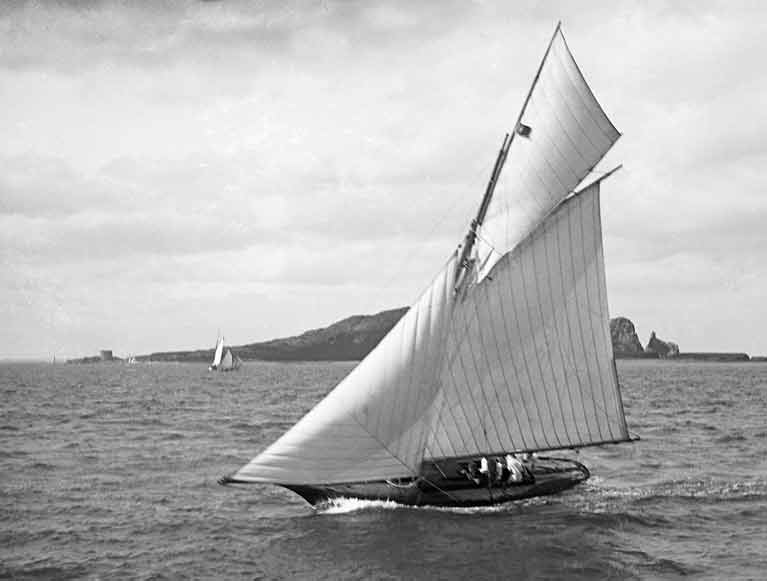 The new 1896-built Marguerite sailing in Howth Sound in the 1890s. Tim Magennis restored her in the 1980s, and has since ensured her future with “Transference of Custodianship” to Guy Kilroy, who is upgrading this historic craft to international classic standards. Photo courtesy HYC
The new 1896-built Marguerite sailing in Howth Sound in the 1890s. Tim Magennis restored her in the 1980s, and has since ensured her future with “Transference of Custodianship” to Guy Kilroy, who is upgrading this historic craft to international classic standards. Photo courtesy HYC
For very many years, Margurite was Tim’s pet boat, a familiar site sitting elegantly on her mooring in Dun Laoghaire’s inner harbour off the DMYC, and a regular participant in DBOGA events. But with advancing years (he turned 90 back in November), Tim reckoned that he had to ensure that Margurite’s future was secure, and in 2017 he “transferred the custodianship” to Dun Laoghaire-based classic boat enthusiast Guy Kilroy, who has commissioned an up-grading of Marguerite to international standards by noted Fingal-based boatbuilder Larry Archer, a meticulous project which will be completed this year.
The London OGA gathering celebrated such projects, large and small, which are underway all over the world. And for the Dublin contingent with their three major awards, it was a very special gathering indeed. But undoubtedly the highlight was Honorary Life Membership for Tim Magennis, a great and engaging character whose infectious enthusiasm, zest for life, delight in traditional rigs, and joy in sailing the sea continues to be an inspiration for the many who know him
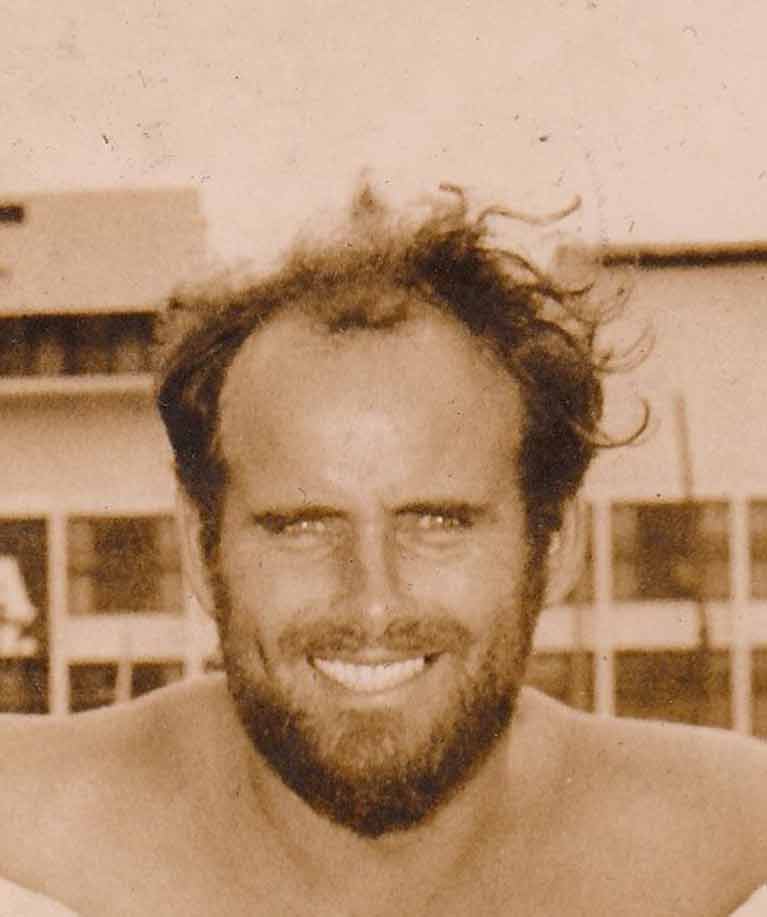 An inspiration to all…..Tim Magennis, now an Honorary Life Member of the Old Gaffers Association, in his younger days during Sandefjord’s round the world cruise in 1965-67
An inspiration to all…..Tim Magennis, now an Honorary Life Member of the Old Gaffers Association, in his younger days during Sandefjord’s round the world cruise in 1965-67
'Fiendishly Tricky' Racing at Cowes Classic Boats Week
It was sun and fun all the way on day five of Panerai British Classic Week 2017 in Cowes, where not only did the participants enjoy some fiendishly tricky racing, but they also finally came together for the traditional Open Yachts Pontoon Party, sponsored by Spirit Yachts and Classic Boat, which had to be postponed from Tuesday because of torrential rain.
On the water the Solent delivered some exceptionally testing conditions as Classes 1 to 4 took part in the Long Inshore Race sponsored by Classic Boat (race six of their series) and the 6 and 8 Metres did two further round the cans races (races six and seven). Conditions were somewhat mixed with a shifty but established south easterly early on in the day. The boats went off the line to the east on a Central Solent course and made good progress until the final reach past Gurnard and along Cowes Green to the finish. By this time the wind was dying and many of the boats seriously struggled to make the line over the strongly ebbing tide. When they eventually did cross, each boat received a rousing cheer from the Squadron Platform to honour their efforts.
Back ashore the Panerai Lounge was buzzing with its usual post racing hospitality, and then at 18.30 everyone moved down onto the pontoons to view and visit the yachts, enjoy free flowing cocktails, delicious food, and live music while they talk classics and generally soak up the amazing atmosphere.
With just one more race to be sailed, a number of the classes have already been decided. In Class 1 Irvine Laidlaw’s Spirit 52 Oui Fling took second place in race six, a mere eight seconds behind Sean McMillan’s Spirit 52 Flight of Ufford with Michael Hough’s Chloe Giselle third. In the overall standings Oui Fling cannot now be beaten and Flight of Ufford is certain of second, but there will be a final race showdown for third place between David Grylls Spirit 46 Helen of Durgan and Chloe Giselle, who are only one point apart.
Giovanni Belgrano’s 1939 Laurent Giles sloop Whooper vanquished her rivals in Class 2 with a fifth win today, but whilst she is assured of victory, Gildas Rostain’s Olin Stephens One Tonner Volonte, Andrew Pearson’s 1937Johans Anker Bermudan cutter Bojar and David Murrin’s 1955 Laurent Giles sloop Cetewayo will take the battle for second and third down to the wire.
A very happy Giovanni Belgrano said of their day, “It was actually a really nice day, a beautiful day. My crew were amazing, we made massive gains through crew work. There were lots of [mark] roundings, and I think we were taking close to a minute per lap out of the boat behind us, mostly through the roundings, and that was purely crew work. I’m very, very happy”
Richard Matthews’ 1963 Stella Scorpio took another win in Class 4, securing overall victory from Simon Payne’s 1961 Nicholson Jolina Damian B, who finished second. Third in Class 4 will be decided tomorrow, as John Mulcahy’s 1963 Stella Estrella and Rufus Gilday’s 40sqm Spidsgatter Venya are tied on 24 points apiece.
Class 3 is still wide open. Michael Briggs’ 1904 Fife 30 Linear Rater Mikado won her fourth race of the regatta today, but Jonathan and Scilla Dyke’s 1938 Robert Clark 10 Tonner Cereste continues to snap at her heels, finishing second today and lying just two points behind Mikado overall. There’s then a thirteen point gap back to Scot Yeates’ 1961 Kim Holman 32 footer Stiletto, but Robert Veale’s 1958 Cheverton designed Danegeld and Tim Yetman’s West Solent One Design Suvretta are both still within striking distance of third.
For the 6 and 8 Meters it was a two race day. Robin Richardson’s 1987 Ian Howlett designed St Kitts won both of the 6 Metre races, putting her onto twenty-five points overall and firmly in striking distance of not only second placed Thistle, ownedy by Tom Richardson, on twenty-three points, but also current leader Sioma, owned by Fenton Burgin, who is on twenty points.
In the 8 Metres Murdoch McKillop’s beautiful 1931 William Fife III designed Saskia claimed both races with Christopher Courage’s 1936 Alfred Mylne designed Helen second in both. The only way in which Helen can now beat Saskia is if Saskia is unable to complete the last race for some reason, so although both boats will race tomorrow, Saskia’s victory is very nearly assured.
You meet a wonderful cross section of sailors at this regatta and amongst this year’s competitors has been Annabel Vose, a member of BAR Racing’s Junior America’s Cup winning team, who has been sailing with Sam Laidlaw aboard the 1966 Sparkman & Stephens 37 footer Clarionet. “It’s definitely a change of pace, but I’ve done the week with Rob and Sam a couple of times already, so it’s fun to be back in the fleet. It’s very different to go from 12 minute races to this one which was nearly five hours, but I’m enjoying it definitely. I’m loving it.” Said Annabel after today’s long inshore race.
Tomorrow’s final races will get underway from the Royal Yacht Squadron start line at 10.00 and the regatta will conclude with the Panerai British Classic Week Prize Giving Dinner and Dance at the Haven Events Centre.
51–Historic Boats for British Classic Week 2017
The opening race day of Panerai British Classic Boat Week 2017 was an absolute scorcher with barely a cloud in the sky and glorious sunshine showing the fifty-one participating classic yachts off to absolute perfection.
The regatta opened with a Parade of Yachts past the Royal Yacht Squadron. Each of the classes and several of the supporting classic motor yachts lined up to parade past Royal Yacht Squadron Rear Commodore Yachting Jonathan Perry who took the salute as the canons fired, much to the delight of the spectators lining Cowes Green.
Unfortunately, the wind was not quite as reliable as the sunshine and a fickle breeze and strong tide gave the navigators and tacticians a lot to think about. The first challenge was getting over the start line safely. The tide was pushing the boats onto the wrong side of the line and the light south westerly was only just sufficient for them to make way against it. Several boats found themselves over the line as the gun went and had to make the slow and painful crawl back up tide to restart correctly.
Once underway the fleet streamed west and into a developing south-westerly sea breeze. The first few legs saw them making good progress, but as they turned back towards the central Solent a competing south-easterly sea breeze tried to fill in too and the net result was a classic Mexican stand-off between the two directions. The resulting game of snakes and ladders was painful for some, but rewarding for others.
In Class 4 former International Moth World Champion Simon Payne, sailing his 1961 Nicholson designed Damian B found both a ladder and a snake, ironically noting, “We led by a country mile at the first mark, but then it all went wrong. We really need more wind.” Whilst Damian B lost out it was a pair of 1963 Kim Holman designed Stellas that showed the fleet the way. On the line Richard Matthew’s Scorpio led John Mulcahy’s Estrella, with Rufus Gilday’s Venya, a 1939 40 square metre Spidsgatter designed by Jac M Iversen, taking third.
In Class 3 Peter Robinson’s lovely Kim Holman Rummer yawl Tinkatoo, built by Stanilands & Co of Yorkshire in 1960, never put a foot wrong. Following them home for second was Tim Yetman’s 1924 West Solent One Design Suvretta, with Robert Veale’s 1958 David Cheverton sloop Danegeld third, and Michael Briggs’ Mikado, a 1904 Fife designed 30 Linear Rater and the oldest boat in the regatta, fourth.
Jonathan & Scilla Dyke’s Robert Clark 10 Tonner Cereste finished the race with high hopes of a second place in Class 3, but unfortunately they had touched two marks during the race and by the time the appropriate penalties had been applied they found themselves down in eighth instead. “I’ve never hit a mark before in my life and I’ve managed to hit two in one race!” Said the slightly embarrassed Jonathan after racing.
Guy O’Bierne, co-owner of Tinkertoo, was delighted with their win, “Today was an interesting day, we’ve not raced since last year, so we just threw ourselves together and went out to see what would happen. The day turned out quite well in the end, we thought we would be around mid-fleet finish!”
Giovanni Belgrano’s 1939 Laurent Giles sloop proved that she hasn’t lost her Class 2 winning ways by beating Lawrence Wride’s Sparkman & Stephens’ One Tonner of 1967 Sunmaid V into second place, with Gildas Rostain’s 1968 Olin Stephens One Tonner Volonte in third.
The racing in the metre boat classes was as tight as ever. In the Sixes, victory went to Charlie Hatfield’s 1946 Nicholson designed Mena with Tom Richardson’s Thistle second and Robert Owen’s Valdai third. In the Eights, Christopher Courage sailing the 1939 Alfred Milne designed Helen took the victor’s laurels from Murdoch McKillop’s Saskia, with Richard Bendy’s Osborne third.
Amongst Mena’s crew is British Double Olympic Medallist Saskia Clark who is finding the transition to big boats interesting. “I’ve retired from Olympic sailing now, and am just finding my way in the big boat world. We’re doing the 6m Worlds in Vancouver in September so this is part of our training for that. Today was our first day racing as a five, and I’m on the foredeck. We had a few little issues, things that didn’t work in terms of equipment that weren’t so smooth. With three Spanish speakers and two English speakers there’s a lot going on to get to grips with. The calmness of my Olympic 470 sailing is a distant memory now, but that’s what we’re aspiring to get to. We’re going to be calm, organised and have routines, it’s going to be good!”
Back ashore the crews took the opportunity to wind down in the sunshine as they enjoyed the post racing hospitality of the Panerai Lounge and the daily prize giving, before moving onto the Panerai British Classic Week 2017 Welcome Reception at the Royal Yacht Squadron.
Tomorrow will see the fleet take on the Around the Island Race sponsored by EFG which will start from the Royal Yacht Squadron at 08.00. For those yachts who elect not to race around the Island there will be an inshore race starting at 10am.
Gentle Start to Friendly Dun Laoghaire Regatta 2017
The difference between an un-sailable calm and a light breeze which is just good enough to provide decent racing is enormous when you’re trying to get a very large regatta off to a successful start. So although the fleet racing on Thursday in the first jousts of the VDLR 2017 in Dublin Bay did not include some classes which became fully involved yesterday, all the heavy hitters were out and racing full-on in a sou’easter which was of exactly the right strength for the first race of a large and complex event.
This years’s special ingredient, the Classics and Traditionals racing for the prestigious Kingstown 200 Trophy, also had their first foray afloat, and W M Nixon found himself in their midst wondering at their almost infinite variety, while getting the occasional glimpse of the racing among the modern fleets.
While the Classics may show themselves to be amenable to a certain level of organisation, trying to get a varied Traditional fleet to function in unison is about as easy as herding cats at a crossroads. So when that remarkable husband and wife team of Con Murphy and Cathy MacAleavey were tasked with setting up a Sub-Committee to look after the special needs of the Classics and Traditionals which were being invited to Dun Laoghaire to compete for the Kingstown 200 trophy within the Volvo Dun Laoghaire Regatta 2017, they found themselves on a steep learning curve, for all that both are already much involved in classic dinghy racing with both the Water Wags and Shannon One Designs.
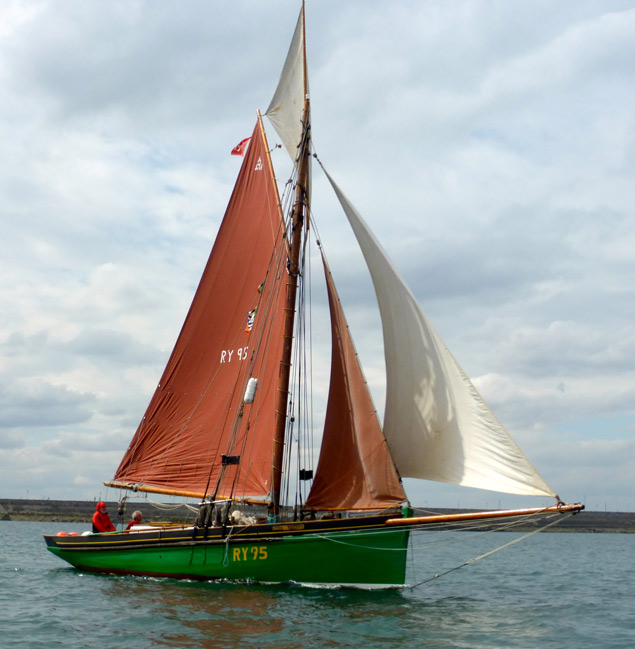 Joe Pennington’s 1895-vintage Manx longliner which he restored himself. He turned up single-handed and more or less unannounced, but has been welcomed and provided with a crew. Photo: W M Nixon
Joe Pennington’s 1895-vintage Manx longliner which he restored himself. He turned up single-handed and more or less unannounced, but has been welcomed and provided with a crew. Photo: W M Nixon
Some of the traditional boats plan their programmes years in advance, while others make them up as they go along. So as entry deadlines came and went, it was still difficult enough to give a realistic assessment of who and what would be there, and where and when.
But with Guy Kilroy of the Water Wags appointed to be the vital direct liaison officer for what is sometimes best described as the Awkward Squad, it was clear that the Murphy/MacAleavey team had taken on board lessons learned from other major commemorative regattas, where attempts to include the Golden Oldies had assumed they were as au fait with the local regular racing scene as though who were frequent participants, and they were too often left to their own devices in a strange environment.
By contrast, the environment in and around the Dun Laoghaire clubs this weekend is about as friendy and un-strange as it could be, and at the National Yacht Club – with special berthing for the Classics and Traditionals along a pontoon immediately east of and parallel to the Carlisle Pier - the Golden Oldies have a home-from-home, and the mood was reinforced by helpfulness and friendliness from the start.
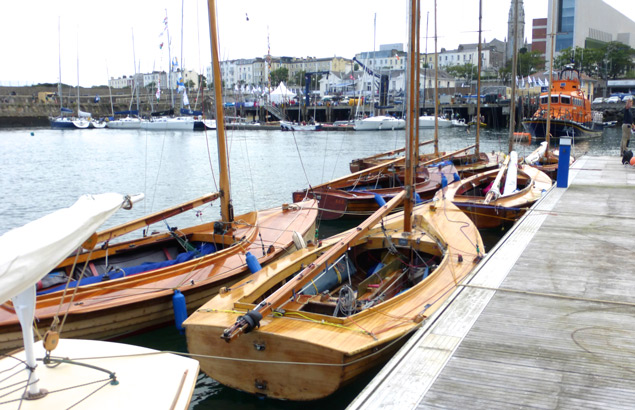 Although the Mermaids have very little class racing in Dublin Bay, the biennial Dun Laoghaire Regatta at their ancestral home is one of their major events. Photo: W M Nixon
Although the Mermaids have very little class racing in Dublin Bay, the biennial Dun Laoghaire Regatta at their ancestral home is one of their major events. Photo: W M Nixon
As to the oldies fleet, it may not be huge, but it’s fascinating in its variety, with a stroll down their dedicated pontoon like a visit to a good maritime museum. And when we add in extras like the Fife ODs over from the Menai Straits, not to mention local fleets almost taken for granted such as the Water Wags from originally 1887 but now racing boats from 1900, the Howth 17s from 1898, the Mermaids from 1932, and the IDRA 14s and the Glens from 1946, then we really are looking at a fine array of wooden boats before we add in the “Honorary Classics”, built in fibreglass but of traditional form.
While the One Designs went off to race with the main fleet, Con Murphy himself took on responsibility for getting the “Mixed Classics” cleanly away from a start line in Scotsman’s Bay on a course which he hoped would keep us clear of most of the cut-and-thrust of the modern machines. Our renowned Race Officer was in a benign mood as it was both his 60th birthday, and he was well pleased with the size and variety of the eclectic fleet which was emerging from the harbour and heading towards his starting area.
 Birthday boy. While in the midst of organising the oldies and classics in their racing for the Kingstown 200 Trophy, they ever-youthful Con Murphy (seen here with Regatta Secretary Ciara Dowling) celebrated his 60th birthday on Thursday. Happy birthday from us all!
Birthday boy. While in the midst of organising the oldies and classics in their racing for the Kingstown 200 Trophy, they ever-youthful Con Murphy (seen here with Regatta Secretary Ciara Dowling) celebrated his 60th birthday on Thursday. Happy birthday from us all!
So in the spirit of the regatta and the mood of the day, the great man asked us what sort of course we’d like, and the popular choice for that first race was a nice reach out and a nice reach back. “And we’d like you to finish in-harbour if that’s okay” added our Race Officer. As gaffers think that finishing in-harbour is the only way to finish, that was no problem either.
Although the basic tide was ebbing southeast out of Dublin Bay, right in there in the inner reaches of Scotsmans Bay we found a distinct west-going counter-eddy, and the good news is that it is indeed indicated in the Port of Dublin Tidal Stream Atlas which we featured on Afloat.ie a couple of days ago. But we also had to take account of it in making our northeast-heading start as by now a grand little southeast breeze had filled in. So pre-start manoeuvres were rather more about avoiding other boats than identifying them too close, but happily the fleet got cleanly away, and as we settled down for a good reach towards the seaward buoy, we could suss them out in more detail and assess the cut of their jibs.
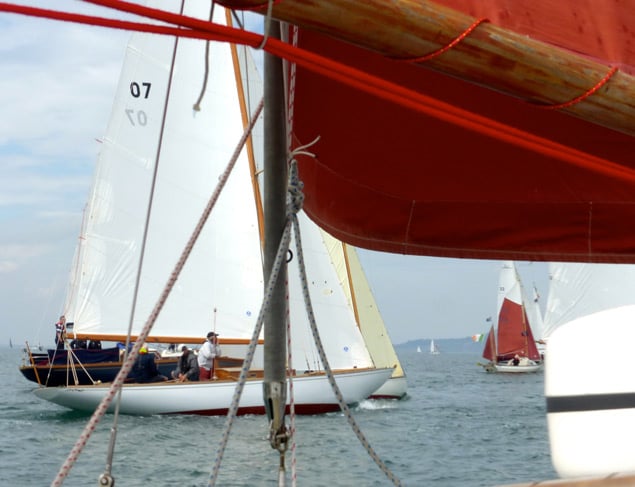 Making in for the start, DB24 Perwinkle, Nicholson 36 Samphire, a brace of Colleens, and an American Morris 44. Photo: W M Nixon
Making in for the start, DB24 Perwinkle, Nicholson 36 Samphire, a brace of Colleens, and an American Morris 44. Photo: W M Nixon
After several major Old Gaffer events in which our boat had raced against Sean Walsh’s Heard 28 Tir na nOg, I’d secured a berth on her with the former International President Old Gaffers Association, which in turn freed up Sean’s crewman John Shaw to go and sail with Joe Pennington from the Isle of Man on the 1895-vintage Manx longliner Master Frank. Typically, Joe had arrived in single-handed and virtally unannounced to take part, knowing he’d find a crew once he got there, and so we found ourselves going through the start line with Master Frank close aboard on the port quarter.
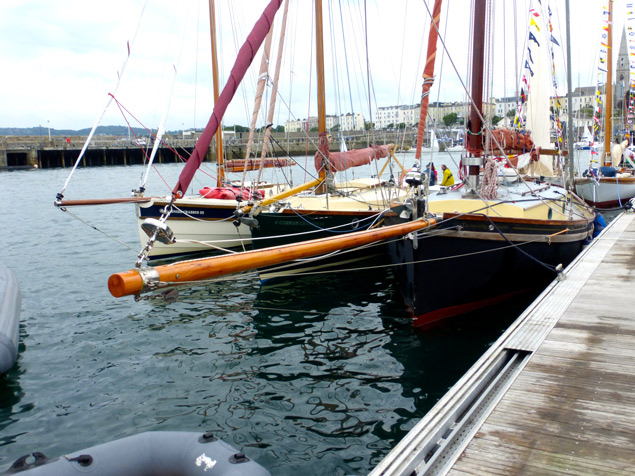 Not a bowsprit to be trifled with……Moving the mast six inches forward has greatly improved the steering characteristics of Sean Walsh’s Heard 28 Tir n nOg. Photo: W M Nixon
Not a bowsprit to be trifled with……Moving the mast six inches forward has greatly improved the steering characteristics of Sean Walsh’s Heard 28 Tir n nOg. Photo: W M Nixon
Aboard Tir na nOg, we were in test pilot mode, as Sean has had the multi-skilled Barry O’Loughlin move the mast all of six inches further forward. Tir na nOg was always a fast boat, but a bit hard on her helm. Now she’s as light as a feather to steer, and even faster with it's soon we were in the groove with topsail up and picking up places left and right, for our start had only been so-so.
Obviously the newly-returned and beautifully-restored Dublin Bay 24 Perwinkle was going to be setting the pace, and she was soon ahead, but as the race went on it was clear the handsome Welsh visitor Myfanwy (Rob Mason) was going like a train. Superficially, she looks like Hal Sisk’s Peggy Bawn of 1894 vintage, but while Myfanwy at three years younger is unrestricted by Rating Rules which were modified after Peggy Bawn was built, consequently she sets more sail, and this was very much her day.
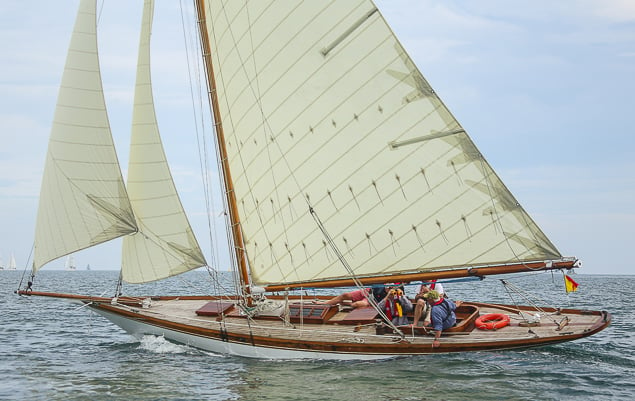 Rob Mason’s own-restored 1897-vintage 36ft Myfanwy from Milford Haven is proving one of the stars of the show. Photo David O’Brien/Afloat.ie
Rob Mason’s own-restored 1897-vintage 36ft Myfanwy from Milford Haven is proving one of the stars of the show. Photo David O’Brien/Afloat.ie
 Hal Sisk’s 1894-vintage Peggy Bawn is sailing with cotton sails preserved by James McAsey, who owned her in Dun Laoghaire from 1919 to 1988. Photo David O’Brien/Afloat.ie
Hal Sisk’s 1894-vintage Peggy Bawn is sailing with cotton sails preserved by James McAsey, who owned her in Dun Laoghaire from 1919 to 1988. Photo David O’Brien/Afloat.ie
Another boat very much having her day was Jack O’Keeffe’s much –travelled Drascombe. “Drascombes don’t race” the committee had been told, but if Jack wasn’t racing, then I don’t know what he was doing. He had his little floating home in flying mode, and finished the race well ahead of many boats you’d have expected to have had him comfortably astern.
 Drascombes aren’t designed to race, but Jack O’Keeffe of Cork has turbo-powered his boat to do just that, and he had a great race. Photo: W M Nixo
Drascombes aren’t designed to race, but Jack O’Keeffe of Cork has turbo-powered his boat to do just that, and he had a great race. Photo: W M Nixo
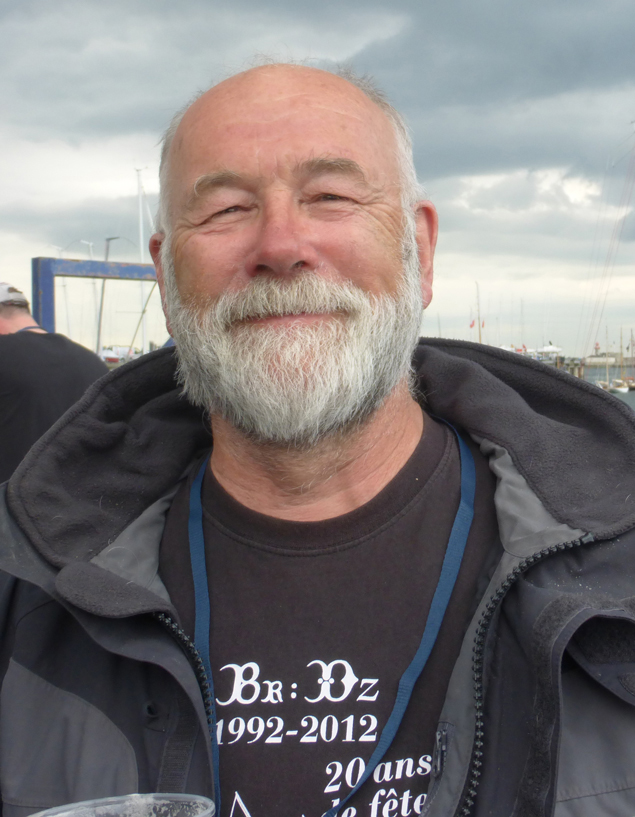 Jack O’Keeffe is the very spirit of Drascombe sailing in Ireland. Photo: W M Nixon
Jack O’Keeffe is the very spirit of Drascombe sailing in Ireland. Photo: W M Nixon
Heading back towards the harbour, we’d the remarkable sight of Dublin Bay Colleens and Peggy Bawn close ahead of us – it could have been any season in the past hundred and more years. But we also had a clutch of Ruffian 23s heading towards us with that single-minded focus which is a Dublin Bay One Design speciality, but may not be in the mental makeup of traditional and classic sailors.
 Frank Larkin of Limerick sailing the Colleeen Bawn in hot pursuit of the Peggy Bawn. Photo: W M Nixon
Frank Larkin of Limerick sailing the Colleeen Bawn in hot pursuit of the Peggy Bawn. Photo: W M Nixon
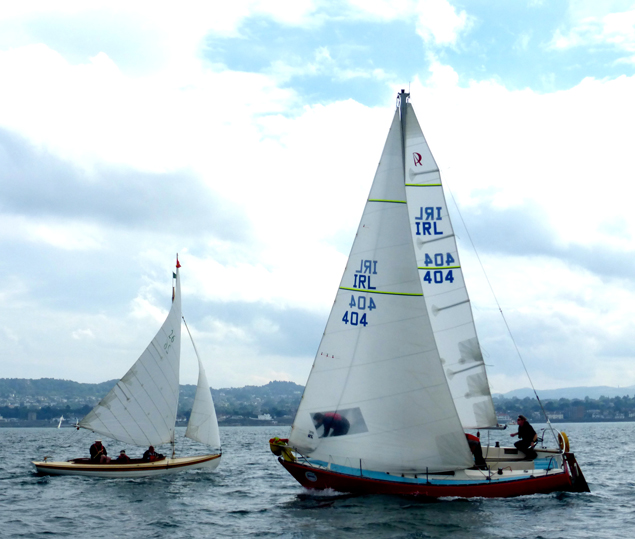 “Don’t you know we’re racing?” “Well, so are we…” Close encounter between Colleen and Ruffian 23. Photo: W M Nixon
“Don’t you know we’re racing?” “Well, so are we…” Close encounter between Colleen and Ruffian 23. Photo: W M Nixon
Fortunately the Classics Sub-Committee’s forward thinking seems to have included the provision of a RIB to shepherd the Golden Oldies around the close-encounters-of-the-first-kind situations which can suddenly arise in the crowded racing waters of the southern half of Dublin Bay, and they tactfully ensured that no-one met by accident.
The in-harbour finish seemed so right for the day that was in it, particularly as we made it in one tack from the harbour mouth to the line. And the mood afterwards was simply euphoric. Half the fleet had been strangers as we joined ship a bit rushed as usual, we got to know them better sailing against them in perfect conditions for the first acquaintance, and we returned to the harbour as friends.
So it took a long time to get from the boats to the club forecourt, not because there was any delay in the ferry shuttle service from pontoon to quayside, but because there were so many different boats – some of them very different indeed - and people to meet, including Rob Mason and his deservedly exuberant crew, who’d made a cracker of a passage to Dublin Bay, just 29 hours from the very head of Milford Haven, and were now racing with an equal elan.
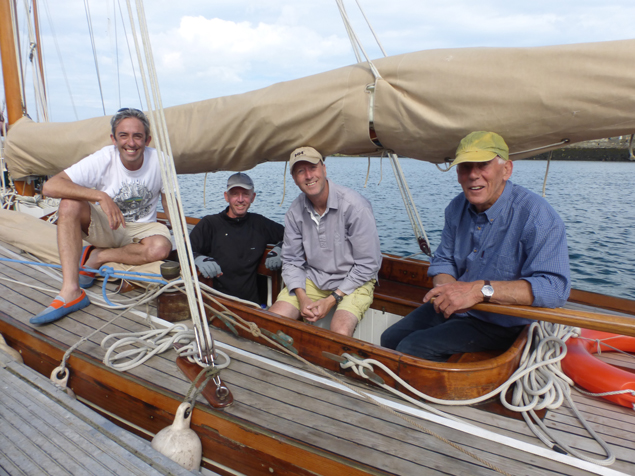 The Flying Welshmen – Myfanwy’s crew with owner, skipper and restorer Rob Mason on right. They made a fast passage from southwest Wales, and have been going even faster since. Photo: W M NixonAnother area of interest was the restored Nicholson 36 Samphire of St Osyth, with which Frank O’Byrne of RStGYC and his gallant team are rightly delighted. They bought her in the south of England with no idea that her first home port in 1963 was Dun Laoghaire with first owner Peter Morck, but now she’s back and a useful indicator for anyone who might be thinking in terms of a moderately priced modern classic such as Brian Comerford has with the Robb 37 yawl Verve of the same vintage.
The Flying Welshmen – Myfanwy’s crew with owner, skipper and restorer Rob Mason on right. They made a fast passage from southwest Wales, and have been going even faster since. Photo: W M NixonAnother area of interest was the restored Nicholson 36 Samphire of St Osyth, with which Frank O’Byrne of RStGYC and his gallant team are rightly delighted. They bought her in the south of England with no idea that her first home port in 1963 was Dun Laoghaire with first owner Peter Morck, but now she’s back and a useful indicator for anyone who might be thinking in terms of a moderately priced modern classic such as Brian Comerford has with the Robb 37 yawl Verve of the same vintage.
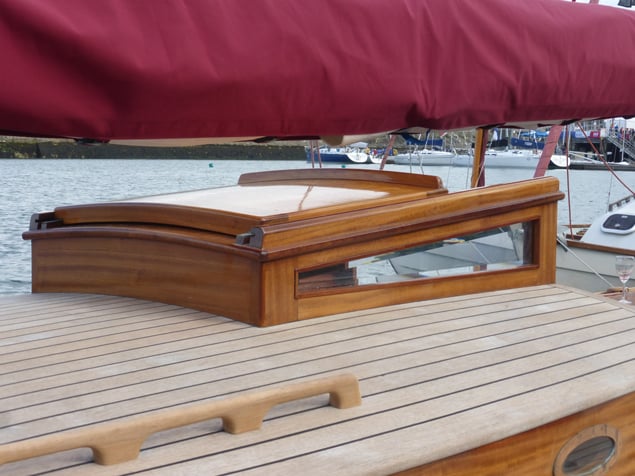 Detail of Perwinkle’s coachroof. The quality of the workmanship by Skol ar Mor in southern Brittany is simply breath-taking. Photo: W M Nixon
Detail of Perwinkle’s coachroof. The quality of the workmanship by Skol ar Mor in southern Brittany is simply breath-taking. Photo: W M Nixon
There are some good boats of a certain age out there just looking for the right TLC to give excellent value, but inevitably in this 200th Anniversary Special regatta, it’s the uber-classics which merit most attention. Periwinkle is simply breath-taking – you just go aboard and sit in awed silence amidst all that exquisite woodwork – the effect of total teak is almost trance-inducing. And last night, the Howth 17s arrived after racing across the bay, insouciant in never having changed from their jackyard topsail-toting gaff rig, so it’s oldies wall-to-wall.
But the sight of sights has to be Peggy Bawn and Myfanwy berthed side by side. 1894 and 1897. Carrickfergus-built and Birkenhead-built. We’ve a remarkable marine heritage in the Irish Sea. And right now, two of the most important examples of it are in Dun Laoghaire to honour the Harbour’s Bicentenary.
 To have two high vintage classic beauties like Peggy Bawn (left) and Myfanwy together in Dun Laoghaire Harbour for the 200th Anniversary makes it all very special indeed. Photo: W M Nixon
To have two high vintage classic beauties like Peggy Bawn (left) and Myfanwy together in Dun Laoghaire Harbour for the 200th Anniversary makes it all very special indeed. Photo: W M Nixon
Les Wags de L’eau a la Semaine de Golfe de Morbihan
Over the next few days fourteen Water Wags will head by ferry to France to participate in one of the greatest classic boat regattas in Europe. As Afloat.ie reported previously, one thousand four hundred and forty two traditional workboats and recreational boats will head to Brittany from Britain, Ireland, Netherlands, Belgium, Switzerland, Austria, Czech Republic, Spain, and Japan.
Among the 19 yachts of the Irish contingent travelling to the celebration of traditional yachting are:
Waterwags: 9, Marie Louise (1927), 17, Coquette (1909), 31, Polly (1984), 32, Skee (1985), 33, Eva (1986), 34, Chloe (1991), 38, Swift (2001), 40, Swallow (2003), 41, Molllie (2005), 44, Scallywag (2009), 45, Mariposa (2015).
Howth 17 ft: Aura (1898), Deilginis (1905), Eileen (1908), Gladys (1907), Leila (1898), Silvermoon (1898).
Others: Anna Panna, a Mcmillan gaff cutter. Sylvana, Moody 46 and possibly the only boat which will sail to the event instead of being trailed.
What a celebration of Irish craftmanship it will be.
Classic Dublin Bay 24 Yacht to Return to Dun Laoghaire
The last time the Alfred Mylne-designed Dublin Bay 24s raced together in their home waters was Saturday, September 25th 2004 writes W M Nixon. Since then, the class has been through various traumas as projects for a group rebuild/restoration in France fell victim to the financial crisis.
However, the boats were kept in store, and two years ago a complete re-build programme for one of them, Periwinkle, was put into action at Skol ar Mor, the pioneering boat-building school in South Brittany run by Mike Newmeyer.
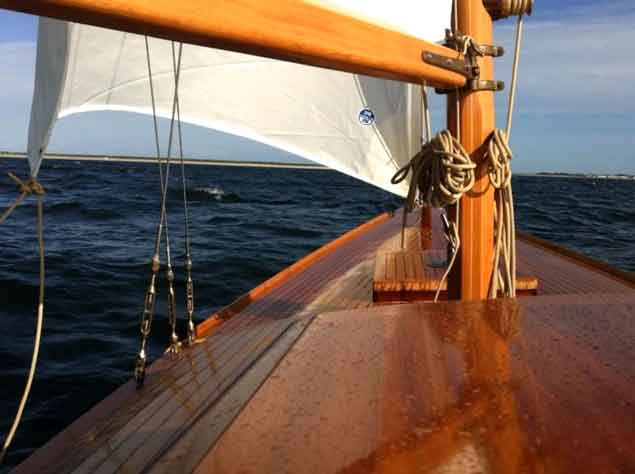 Sailing aboard the restored Periwinkle. The quality of the bronze fittings on the mast matches the high standard of the restoration. Photo Brian Mathews
Sailing aboard the restored Periwinkle. The quality of the bronze fittings on the mast matches the high standard of the restoration. Photo Brian Mathews
Perwiwinkle has turned all heads any time she goes sailing, but there’s no doubt she’d make most impression in an active class setting. As it is, for this year’s Morbihan Festival of Classic and Traditional Boats in the last full week of May, she’ll be sharing the waters of that noted inland sea with boats from home, as twelve Dublin Bay Water Wags and eight Howth Seventeens are being trailed, ferried, and trailed again to take part in one of the greatest gathering of character boats in the world.
 Water Wags in festive mode for their 125th Anniversary in 2012 at Dun Laoghaire Harbour mouth. In ten days time, 12 of them will be in France en route to the Morbihan Festival
Water Wags in festive mode for their 125th Anniversary in 2012 at Dun Laoghaire Harbour mouth. In ten days time, 12 of them will be in France en route to the Morbihan Festival
But while the Water Wags and the Howth Seventeen will be sailing in the enormous fleet, Periwinkle will be on static display afloat, alongside the Skol ar Mor booth at the boat show in the port of Vannes at the head of the Morbihan, though there is a possibility that renowned designer Francois Vivier will take her out for a sail. Happily, though, she’ll soon definitely be sailing – and she’ll be sailing to Dublin Bay.
Owners Chris Craig and David Espey are determined to get her back in time for the Classics Division in the Volvo Dun Laoghaire Regatta from 6th to 9th July, and will be sailing her up from Brittany with a target time of 1st July pencilled-in for arrival in Greystones. Their hope is that former DB24 sailors will then join them to sail on to Dun Laoghaire on Sunday July 2nd.
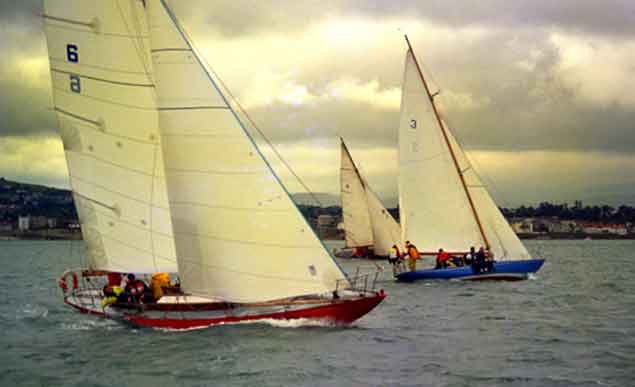 Class racing act. The Dublin Bay 24s in action at the Dun Laoghaire Woodenboat Regatta 1997. Photo: W M Nixon
Class racing act. The Dublin Bay 24s in action at the Dun Laoghaire Woodenboat Regatta 1997. Photo: W M Nixon
As for the rest of the DB24 fleet, their elegant yet tired hulls are finding new purpose in boat-building schools. In September, Adastra will go to Albaola Scholl in San Sebastian in northern Spain, Zephyra is being shipped across the Atlantic for the Apprentice Shop in Maine, and Arandora is to be completed in Les Atelier de L’Enfer in Douarnenez in Brittany. Mike Newmeyer is working on a plan for Euphanzel, and various proposals are being discussed regarding the future of Harmony and Fenestra.
It has been – and still is - a long and difficult journey. But the arrival of Periwinkle in Dublin Bay will surely be a very significant step



























